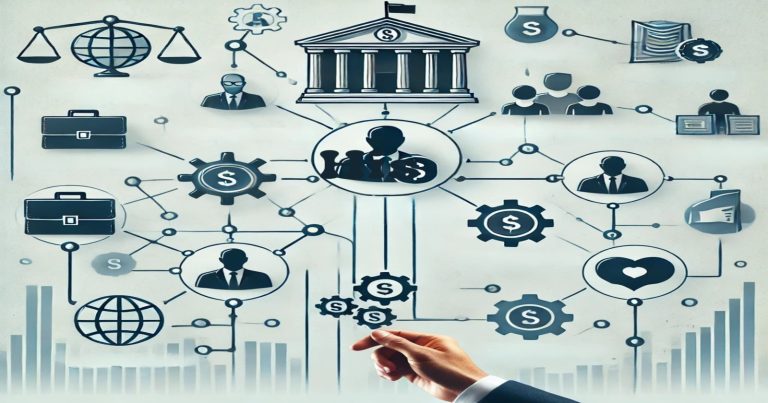Key stakeholders are those individuals, groups, or organizations that have a vested interest in the outcome of a project or a business. They’re essential to decisions, planning and success. So, who are the key stakeholders? The answer is simple- Stakeholder is any person affected by or able to affect the work. These can be customers, employees, suppliers, government institutions, and investors. And sometimes the community can also be a stakeholder, if a company’s work has an impact on them.
It allows the work to run smoothly and objectives to be achieved on time when you collaborate with the system customers and key stakeholders. They support your plan, provide feedback, and express their needs. We know from the key stakeholders definition why these people need to be involved from the very start of any work. And their considerations and requirements play a significant role in the improvement of the manufacturer, tourism region, or even a school.
In this article, we will explore the list of key stakeholders, the significance of key stakeholders across various sectors such as tourism, how to identify them, and how to influence key stakeholders. We will also understand the who are key stakeholders in a company and how to address their requirements in an easy and smart way. Now, let’s explain this in simple steps.
What is the Meaning of Key Stakeholders?
The focus here is on how to easily define key stakeholders. You will know who they are and why they’re important.
Key Stakeholders Definition
According to the key stakeholder definition, they are the primary individuals or groups that are going to be involved or impacted from any decision, or an outcome of any project. These stakeholders may be both external and internal. Internal ones are the ones that work inside the organization. External ones are from outside.
What Stakeholders are and What They Do?
This is a straightforward way to see what they do:
- Examples of internal stakeholders include employees, managers, and owners.
- External stakeholders consist of customers, suppliers, investors, and government.
For instance, if a school wants to make changes in its rules, the stakeholders will be students, parents, teachers and the school board. When something changes for the good, everyone ultimately wins. If not, trouble awaits them all. That is why their ideas and feedback are so helpful.
Key Stakeholders Meaning in Simple Words
So if you want a brief key stakeholder definition: Key stakeholders are those people who aid or are impacted by your work and decisions. Their support is necessary to arrive at your ambitions.
Types of Stakeholders
Stakeholders are individuals or groups who are interested in a company’s actions, decisions, and success. These groups are able to impact or be influenced by a business. The stakeholders are a significant part of business growth, sustainability, and function of the organization. Analyzing the types of stakeholders helps organizations to understand expectations, mitigate risks, and improve collaboration. The stakeholders will vary between different types of work.
| Type of Stakeholders | Their Role |
| Customers | They use your product or service |
| Employees | Work inside company |
| Managers | Make plans and decisions |
| Investors | They give money to grow |
| Suppliers | Provide goods and materials |
| Government | Fix rules and give permissions |
| Community | Affected by actions of company |
| Media | Share public news or updates |
There is a unique perspective for every stakeholder. Hence ensuring their involvement is crucial. You need to have communication with them on regular basis to understand their requirements and resolve any issue at beginning.
How to Identify Stakeholders
You can use these ways:
- Resources: Look at who provides or receives resources
- Consider who will be impacted by the result.
- Who can (and will) foil your plan — and who can help you?
Once you identify your key stakeholders, you can do a better job of including them in meetings and updates.
What are Key Stakeholders in a Company?
Every company has its own set of major players. First, let us understand who are the key stakeholders in a company and what they do.
The Main Stakeholders in Company
The main stakeholders of a company are:
- Owners and Shareholders –They lie on profit and growth.
- Employees – Job safety and good work life.
- Customers — Desire quality and service
- Goods – They need consistent orders and cash.
- Government — It wants companies to obey laws.
- Community – it wants to talk business and receive support.
They have to be part of any company meeting or decision-making step. And their ideas will enable the company and to grow trust.
Importance of Stakeholders in a Business
- They provide input in order to enhance the product.
- And sometimes they need to invest money or time to help things grow.
- They can say good things or bad things about your brand.
For your company to successfully evade accurate loss. They can be useful and help you develop rapidly, that is if you listen to them.
Key Stakeholders in Tourism
Tourism has its own form of stakeholders. Let’s find out who they are and what they do for the travel business.
A Brief History of Key Stakeholders in Tourism
In the context of tourism, some of the key stakeholders are:
- Tourists – These are the main customers.
- Tourist industry jobs – These include things like travel and ticket booking agencies.
- Hotel Owners – Offer accommodation and food.
- Local Governance – Issuance of licenses and safety regulations.
- Local Community – Provide experience and tradition.
They each have their own special role to play. It will take cooperation on all their parts for tourism to grow. If one group has a problem, the entire experience can go haywire.
Significance of Tourism Stakeholders
When you collaborate with the system customers and key stakeholders, tourism becomes seamless and safe.
For example:
- To teach the culture to tourists, local people are of help.
- Stay, food and what not at your local hotels.
- Amenities can help you construct roads and signposts.
It’s all those little steps that work towards bringing in more tourists and boosting the local economy.
Key Stakeholders in a Project
If you do not have support from your stakeholders, projects will fail. Discover who the key stakeholders in a project are and how you can be involved with them.
Who Are Project Stakeholders?
They include:
- Project Sponsor – Provides funding and support.
- Project Manager – Starts and coordinates everything.
- Team Members – Performs the actual work.
- Clients – Get the deliverable of the project.
- Regulators — Verify compliance with the law.
All projects require good communications with these groups. If you don’t ask them to weigh in up front, you could face major delays.
How to Collaborate with Stakeholders in Your Project?
Follow these steps:
- Map all your stakeholders out from the beginning.
- Figure out a time to connect with each of them.
- Get their input before making major changes.
- Share updates regularly.
- Express gratitude and celebrate wins — however small.
And if you manage these people right, your project completes on time, under budget, and with a bang.
How to Influence Key Stakeholders
If you want to scale your business or finish your project, then you have to learn how to influence key stakeholders. This involves getting them to align with and support your plan.
Methods for Affecting Stakeholder Behavior
- Gain Trust – Be transparent and keep your word.
- Benefits – Explain what they will get
- Run the Distributed Load – Understand what they are concerned about.
- Problem Solving – Reduce problems to fix them faster.
- Collaborate Cross Functionally – Work together.
This will earn the respect of your stakeholders. They will believe in your plan and align with your goals.
Why Influence Matters
Fail to learn how to influence key stakeholders and you’ll lose their confidence. Your work may turn out less well, without their assistance. But they’ll help you solve problems quickly and achieve those goals even more quickly.
Relevance to ACCA Syllabus
Stakeholder identification, analysis and, how ethical responsibility lies with the stakeholder, is a topic which appears clearly in the ACCA syllabus. It is the case at Strategic Business Leader (SBL) level, as well as in Governance, Risk and Ethics. It is the very key in any field or environment, be it in workplaces for effective leadership, empowering communication or value generation.
Key Stakeholders ACCA Questions
Q1. Who among the following is an internal stakeholder?
A. Supplier
B. Shareholder
C. Customer
D. Employee
Answer: D. In general, as business operations happen daily, everyone who is involved with it on a day-to-day basis is an internal stakeholder or someone who contributes to the success of the business.
Q2. The role of stakeholders in corporate governance
A. They prepare financial statements
B. They regulate tax policies
C. They set ethical and strategic decisions
D. Company make equipment company use
Answer C Stakeholders include shareholders and regulators, influencing corporate governance.
Q3. Who are Connected Stakeholders?
A. Government
B. Competitor
C. Customer
D. Employee
Answer: C Customers are connected stakeholders as they participate in value exchange with the business but are not internal or regulatory
Q4. How often should companies engage regularly with stakeholders?
A. To comply with labor laws
B. Jingle all the way to the market
C. Trust and sustainable relations
D. To increase tax deductions
Answer: C Engagement helps companies align with stakeholder expectations and in the long run, helps earns trust.
Q5. Who owns votes on decisions by the corporation?
A. Suppliers
B. Employees
C. Customers
D. Shareholders
Answer: D Shareholders have a say at annual general meetings and can influence the business strategy.
Relevance to US CMA Syllabus
Key Stakeholders are central to Part 1: Financial Planning, Performance and Analytics and Part 2: Strategic Financial Management. The CMA test guides you through skills focused on supporting internal and external stakeholders in governance and decision-making and encourages compliance with the law.
Key Stakeholders US CMA Questions
Q1. What stakeholder group is most concerned with the firm’s success as a business?
A. Media
B. Customers
C. Shareholders
D. Community
Answer: C Shareholders will closely watch financial return on capital put in.
Q2. Stakeholder Analysis in Strategic Planning It serves the following purposes:
A. Avoiding audit procedures
B. Defining internal policies
C. To match objectives and stakeholder alignment
D. Filing tax returns
Answer: C Stakeholder needs and strategic plans work in tandem for best performance.
Q3. An example of an external stakeholder is⎯
A. Manager
B. Auditor
C. Employee
D. Director
Answer: B Auditors are the external stakeholder of a business that has an interest and is responsible to ensure transparency and fairness in the financial statements.
Q4. When would need to reach out to the stakeholders?
A. During normal operations
B. During system shutdowns
C. At a time of change or crisis
D. At fiscal year-end
Ans: C They should be sensitive to it, and be involved during a crisis or a particle business event.
Q5. Which stakeholder group is concerned about environmental impacts?
A. Customers
B. Government
C. Competitors
D. Shareholders
Answer: B Governments regulate and are responsible for keeping companies responsive to environmental issues.
Relevance to US CPA Syllabus
Business Environment and Concepts (BEC) and Regulation (REG) focus on stakeholder knowledge. CPA Candidates must be well-versed in issues of corporate governance, responsibilities to the public interest and how businesses navigate relationships with multiple stakeholders.
Key Stakeholders US CPA questions
Q1: What is the role of stakeholders in financial statements audit?
A. They define the audit process
B. They invest in audit firms
C. They use audit reports to perform decision making
D. They draft the financial statements
Answer: C Investors and regulators rely on audits when they make investment and regulatory decisions.
Q2. Which of the following stakeholders is most relevant in the context of CPA ethical responsibilities?
A. The CPA firm’s competitors
B. Clients and the public
C. Social media platforms
D. Industry consultants
Answer: B CPAs are obligated to act in the public interest and to maintain trust with clients.
Q3. Although stakeholder analysis is not a silver bullet for regulatory compliance, if done well, it can help organizations better manage stakeholder engagement, facilitate change management, and maintain positive stakeholder relations.
A. To understand market share
B. To fit cultural norms
C. To maintain the people law abiding
D. To benchmark with peers
Answer: C The extent of compliance to legal and ethical standards is driven by stakeholder expectations.
Q4. What is the stakeholders biggest concern inside REG section?
A. Shareholder voting rights
B. Tax policy and compliance
C. Audit quality
D. IT governance
Ans: B Because REG deals with taxation, it might appeal to the largest number of possible people/clients
Q5. Which of the following is a key user of financial statements?
A. Auditors
B. Tax authorities
C. Shareholders
D. Vendors
Answer: C The purpose of financial statements is to give shareholders a measure on how to value the company.
Relevance to CFA Syllabus
Stakeholders play a key role in Ethical and Professional Standards, Corporate Issuers, and Portfolio Management. CFA candidates are expected to assess stakeholder impact on firm valuation, strategy, and risk management.
Key Stakeholders CFA Questions
Q1. Corporate governance; who supervises the board?
A. Suppliers
B. Employee s
C. Shareholders
D. Customers
Answer: C The shareholders elect the board and expect them to be accountable for their investment.
Q2. To which stakeholder do the dividend policy decisions matter most?
A. Employees
B. Analysts
C. Shareholders
D. Creditors
Answer: C Dividends are a cash payment made to shareholders, so that makes shareholders impacted by such decisions.
Q3. What is the fundamental connection between investment analysts and stakeholders?
A. To boost company profits
B. To manipulate stock prices
C. Corporation risk and governance analysis
D. To aid marketing campaigns
Answer: C Stakeholder relationships demonstrate the risk dependencies and risk governance that must be incorporated into the valuation.
Q4. Portfolio management decision making is driven by stakeholder objectives.
A. Market share growth
B. Strategic HR decisions
C. Willingness to take risks and desired returns
D. Product branding strategy
ANSWER: C Portfolio risk and return objectives are set by investor stakeholders.
Q5. Which Of The Following Is An Example Of Stakeholder Conflict?
A. Board approval of dividend
B. Shareholders wanting more return versus employees wanting more salary
C. Audit sign-off
D. Financial report issuance
Ans: B There are always varying expectations of stakeholders, and tensions tend to arise around expectations of money.


